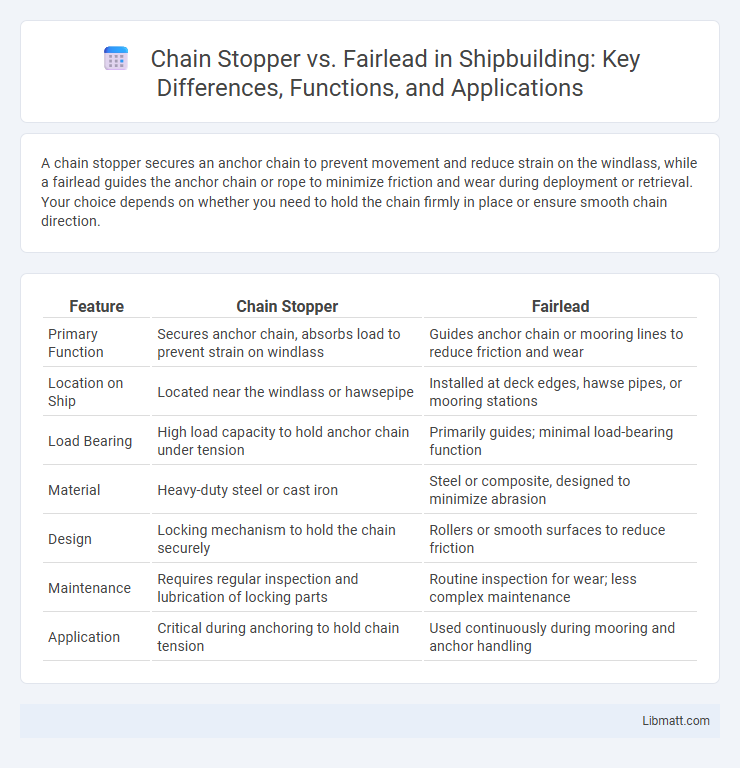A chain stopper secures an anchor chain to prevent movement and reduce strain on the windlass, while a fairlead guides the anchor chain or rope to minimize friction and wear during deployment or retrieval. Your choice depends on whether you need to hold the chain firmly in place or ensure smooth chain direction.
Table of Comparison
| Feature | Chain Stopper | Fairlead |
|---|---|---|
| Primary Function | Secures anchor chain, absorbs load to prevent strain on windlass | Guides anchor chain or mooring lines to reduce friction and wear |
| Location on Ship | Located near the windlass or hawsepipe | Installed at deck edges, hawse pipes, or mooring stations |
| Load Bearing | High load capacity to hold anchor chain under tension | Primarily guides; minimal load-bearing function |
| Material | Heavy-duty steel or cast iron | Steel or composite, designed to minimize abrasion |
| Design | Locking mechanism to hold the chain securely | Rollers or smooth surfaces to reduce friction |
| Maintenance | Requires regular inspection and lubrication of locking parts | Routine inspection for wear; less complex maintenance |
| Application | Critical during anchoring to hold chain tension | Used continuously during mooring and anchor handling |
Introduction to Chain Stoppers and Fairleads
Chain stoppers secure the anchor chain, preventing undue strain on the windlass and ensuring vessel stability, while fairleads guide the chain smoothly to avoid wear and tangling. Understanding the function of both devices enhances your vessel's anchoring system, improving safety and efficiency during anchor deployment and retrieval. Proper selection between chain stoppers and fairleads directly impacts chain longevity and operational reliability.
Definitions: What is a Chain Stopper?
A chain stopper is a mechanical device installed on a ship's deck to secure the anchor chain, preventing it from moving under load and reducing strain on the windlass during anchoring operations. It ensures the anchor chain remains firmly locked in place, enhancing safety and operational efficiency. Unlike a fairlead, which guides and channels ropes or chains without securing them, a chain stopper provides a locking function essential for holding the anchor chain securely.
Definitions: What is a Fairlead?
A fairlead is a device used on ships and boats to guide ropes, cables, or chains smoothly over a surface, reducing friction and preventing damage. It typically consists of a ring, roller, or a slot through which the line passes, ensuring controlled direction and tension. Understanding the role of a fairlead helps you optimize line management and enhance safety during mooring or anchoring operations.
Purpose and Functionality Comparison
A chain stopper secures the anchor chain, absorbing the load and preventing strain on the windlass during anchoring operations, while a fairlead guides the chain or rope smoothly onto the deck or capstan, reducing friction and wear. Chain stoppers are critical for holding the anchor in place when the vessel is stationary, ensuring safety and stability. Fairleads improve handling efficiency by maintaining proper chain alignment, minimizing damage to both the chain and vessel fittings.
Key Design Differences
Chain stoppers are designed primarily to secure heavy anchor chains, featuring robust locking mechanisms and heavy-duty materials to withstand extreme tension and shock loads. Fairleads, on the other hand, guide ropes or chains to prevent abrasion and maintain alignment, typically employing rollers or smooth surfaces to reduce friction. Understanding these key design differences ensures you select the appropriate equipment for anchoring reliability and vessel safety.
Applications in Marine and Offshore Settings
Chain stoppers secure anchor chains by absorbing tension loads, preventing damage to windlasses and enhancing safety on vessels in marine and offshore settings. Fairleads guide anchor chains or ropes smoothly over the vessel's deck edges, minimizing chafing and ensuring efficient deployment and retrieval in harsh sea conditions. Understanding the distinct roles of chain stoppers and fairleads optimizes your vessel's anchoring and mooring performance in demanding maritime environments.
Materials and Durability Considerations
Chain stoppers are typically constructed from heavy-duty steel or stainless steel to withstand high loads and harsh marine environments, providing superior durability for securing anchor chains. Fairleads are often made from bronze, aluminum, or high-strength polymer composites, offering corrosion resistance and reduced wear on ropes or cables but generally lower load capacity than chain stoppers. The choice between these fittings depends on balancing material strength, corrosion resistance, and the type of marine applications to ensure long-lasting performance under varying stress conditions.
Installation and Maintenance Practices
Chain stoppers are installed directly on the vessel's deck and require precise alignment to ensure proper load distribution and secure anchoring, necessitating regular inspection for wear and corrosion on pins and bolts. Fairleads, typically mounted at the bow, guide the anchor chain or rope and demand routine maintenance to check for abrasion and damage on rollers, frames, and lubrication points. Both components must be maintained under stringent marine standards to prevent operational failures and extend service life.
Safety Implications and Best Practices
Chain stoppers and fairleads serve distinct roles in mooring safety, with chain stoppers designed to absorb shock loads and prevent chain overstrain, while fairleads guide the mooring lines to reduce chafing and wear. Ensuring the correct use of a chain stopper is critical for maintaining structural integrity under high tension, whereas proper fairlead positioning minimizes line damage and enhances durability. You should regularly inspect both components for signs of wear or deformation to uphold optimal safety standards and prevent potential failures during vessel operations.
Choosing Between Chain Stopper and Fairlead
Selecting between a chain stopper and a fairlead depends on the vessel's anchoring setup and operational needs. Chain stoppers are designed to secure the anchor chain firmly and reduce strain on the windlass, enhancing safety during heavy loads. Fairleads guide the anchor chain smoothly, minimizing wear and preventing chafing but provide less direct load-bearing support compared to chain stoppers.
Chain stopper vs fairlead Infographic

 libmatt.com
libmatt.com